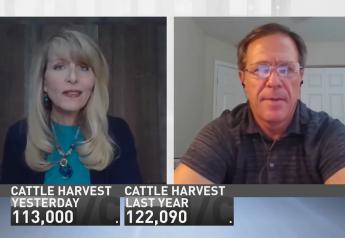Are 100-Bushel Soybean Yield Averages On The Horizon?

What’s possible for U.S. soybean crops to ultimately yield is anyone’s guess. What's currently known? Yields above 200 bushels are possible. That fact was proven by the record-shattering 206.7997 bushels per acre yield Georgia grower Alex Harrell achieved this past August in the Georgia Soybean Production Contest.
Still, there’s a huge gap between that yield record and what U.S. soybean growers currently average across the country. As of Oct. 1, USDA’s average soybean yield forecast stood at 49.6 bushels per acre, roughly a quarter of Harrell’s achievement.
“I think it's pretty exciting that the record was broken, and I think it leads into the discussion about what's it going to take to average 100 bushels of soybeans? What do we need to do differently?” says Scott Kay, vice president of U.S. Agricultural Solutions at BASF.
According to BASF’s projections, there’s no doubt that more soybeans will be needed in the future. “Between food and fuel, we have an estimate that by 2050 we will need 60% more soybeans than we currently produce,” says Kay, who led a recent panel discussion on practices to increase soybean yields.
How can U.S. farmers get to that 100-bushel yield average? From BASF’s perspective it will require an integrated approach that focuses on the details from variety selection to in-season management – addressing weeds, disease and insects – along with using yield data effectively.
Variety Selection and Early Management
“I think one of the first things that we need to solve is variety selection,” says Ryan Myers, who farms with his family near Fairbury, Ill. “I think that varieties are going to have to improve, and then we're going to have to place those varieties on the correct acre of the farm to achieve that 100 bushels to the acre.”
Myers says agronomists and seed sales representatives do a good job of helping him determine which varieties will perform best on the various soil types he farms, and that process has helped him increase yields.
“We’ve gone from a 60-bushel-per-acre yield average in the past three years to 70-plus bushel averages now,” he says.
One area Myers believes needs more scrutiny on his farm, however, is planting population. Currently, he uses a planting population of 140,000 across the board.
“I always feel like that could be changed, but I'm not sure exactly how to do it, or what's the way I need to go about it,” Myers says.
As farmers think about how to maximize how a variety yields, they can also benefit from considering two other components—environment and management, according to Marc Hoobler, BASF agronomy lead. He says there’s more to the environment than simply weather conditions.
“We like to get down to the field level environment, to understand where water is flowing to and from, and understand the different soil types, organic matter and soil pH,” Hoobler says. “All of that factors into how a variety likes to build yield.”
Early Planting Can Help
Hoobler says BASF is a proponent of planting soybeans early, and he notes that every day past April 15 Midwest farmers lose about a half bushel a day in yield potential.
“We really like to get seed in the ground early and not focus so much on soil temperature but on soil condition,” Hoobler says. “When it's ready, go ahead and plant beans before corn. I think that's a mindset shift that we're trying to get established to really push soybean yield. I think we're leaving a lot of yield on the table by not really paying as much attention to soybeans as we should with some of these things.”
Along with early planting, Myers says he is a stickler for planting soybeans at a consistent depth. To get fields fit for early planting, he uses vertical tillage.
“It makes the ground a little blacker so it maybe handles frost a little better. That's going to help with emergence and make it a little more even, in our opinion,” he adds.
With planting soybeans earlier, Myers says he believes seed treatments are a critical component for success.
Hoobler adds that because early planted soybeans tend to sit in the ground for longer periods of time prior to emergence, they benefit from a seed treatment for protection against issues such as Sudden Death Syndrome and Soybean Cyst Nematode.
“With a strong genetic package and a seed treatment you've got a really solid, defensive type of soybean that can go after yield,” Hoobler says.
Address Weeds Proactively And In Multiple Ways
U.S. farmers spend upwards of $26 billion annually on weed control in soybeans, Kay reports.
“It’s $50-plus an acre now in many cases to control weeds in soybeans – double what it was 10 years ago,” he says.
Increasingly, farmers are having to deal with more herbicide-resistant weed species such as Palmer amaranth (pigweed), waterhemp, lambsquarters, common and giant ragweed and marestail (horseweed).
In Myers’ case, waterhemp is the driver weed he builds his weed control program around.
“We want to plant into a clean field, so our weed control program starts with a fall burndown treatment,” he says. “We then come back in the spring and lay down residual with the preemergence. From there, we play it by ear to see what’s needed.”
Myers says using multiple modes of action and multiple residual products during the growing season has helped him stay a step ahead of weed pressure.
This past summer, Myers adds that he had the opportunity to try a smart sprayer system to address weeds.
“As you're driving through the field, if there's a weed it only sprays that one weed. And the really neat thing about it is that you're able to also spray residual at the same time,” Myers says.
“The cost savings of going out to a field and applying 10% of the field with a contact herbicide, along with laying down residual for protection further on, is amazing technology. That technology is coming quickly, and it's going to be a game changer for a lot of people,” he adds.
Using Data Effectively Will Boost Yield
In addition to farming, Myers works a full-time job as an integrated solutions consultant for a John Deere dealership.
“One of my duties at the dealership is to manage people's data, taking their data off of their planters and their applicators throughout the growing season and making sure that it's on a platform that they understand and then tying that back to their yield data so they can do comparison maps,” he says.
Myers says it concerns him that many farmers do not use their data to build more soybean yield.
“They don't pull that data off and put it into any type of a platform that allows them to review it throughout the season,” he says.
“I think we're really close to the point that having the past history of yield data and application maps and soybean variety history – that’s going to be extremely beneficial to the people that have kept track of it and compiled that data for use in the near future to increase yields,” he adds.
Field data will help seed salesmen and agronomists put together more prescriptive seed selection recommendations by field and perhaps even within fields, says Nick Fassler, director of technical services for BASF.
“Decisions in agriculture need to be data driven,” Fassler says. “The more information you have about your field, about the variety and how they how they match up, the better your yield outcomes are going to be.”
4 Reasons Why You Should Care About South America
Three Ways to Be a Successful Soybean Yield Sleuth
Bayer And Corteva Sell 50%+ of the Corn, Soybean and Cotton Seed in the U.S.
Harvest Adjustments to Set Up For the Best Planting Season
Two Likely Dicamba-Resistant Waterhemp Populations Found In Iowa
New Soybean Fungicides Target White Mold and Phytophthora Root Rot







